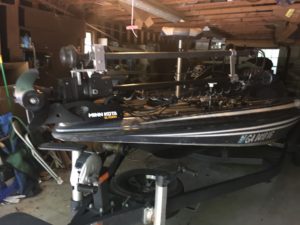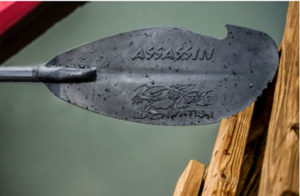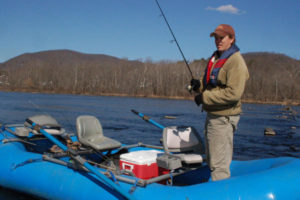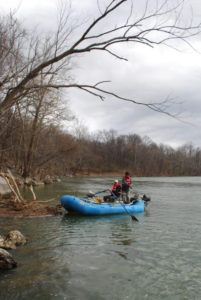Boating Michigan’s ‘Water Wonderland’
By CASEY WARNER
Michigan Department of Natural Resources
from The Fishing Wire
In Michigan – a state with more than 3,000 miles of Great Lakes shoreline, more than 11,000 inland lakes and more than 36,000 miles of rivers and streams – you are never farther than 6 miles from a body of water or 85 miles from a Great Lake.
With such an abundance of water to enjoy, it’s no wonder Michigan is home to 4 million boaters. The state ranks third in the nation for both watercraft registrations and total expenditures for sale of new powerboats, trailers and accessories.
“Water is one of Michigan’s greatest natural resources,” said Ron Olson, chief of the Michigan Department of Natural Resources Parks and Recreation Division. “We encourage residents and visitors to get out and explore all of the on-the-water opportunities the Great Lakes State affords. Michigan is truly a boater’s paradise.”
Making sure the state’s millions of boaters have ample opportunity to get their boats out on the water is the focus of the DNR’s Waterways Program.
“There are over 1,300 state-sponsored boating access sites throughout Michigan and 82 state-sponsored harbors along the Great Lakes – at a total value of over $1 billion,” said Jordan Byelich, DNR waterways development program manager.
Byelich explained that funding for public recreational boating facilities – land acquisition, design, construction, operation and maintenance – comes from boat registrations, the Michigan marine fuel tax and user fees. Projects also may be funded, on occasion, with federal dollars through the U.S. Fish and Wildlife Service and U.S. Coast Guard.
“We have a boating team made up of planning/development, grant management, operations and regulatory experts,” Byelich said. “Our 11 major maintenance crews and two construction crews perform various forms of specialized boating facility construction, including launch ramps, skid piers, vault toilets, parking lots, sidewalks and channel dredging.”
The DNR has renovated several boating access sites and harbors around the state.
One example is the recently constructed and expanded piers for mooring along Snail Shell Harbor at Fayette Historic State Park in Delta County, which offers a floating dock system with seven finger piers – one that is 38 feet long, two that are 45 feet long and four that are 60 feet long.
“This was a great improvement for visitors to Fayette Historic State Park,” said Olson. “The old dock was removed during the fall of 2015. The new pier system is quite beautiful.”
As part of a major reconstruction project at East Tawas State Harbor in Iosco County, boaters now can access modern amenities, improved safety features and a better connection to the local community.
The project helps the harbor respond to current trends in Great Lakes boating. The facility now features many enhancements, including new piers, a greater variety of slip sizes, compliance with the latest Americans with Disabilities Act standards, new electrical pedestals, as well as a new pump-out system.
“The harbor currently has 160 slips, with all brand-new floating docks,” said Micah Jordan, lead ranger/supervisor at Tawas Point State Park and East Tawas State Harbor. “It is maintained by an all-new electrical system that detects and reports electrical current in the water, meeting the new federal codes for harbors and marinas.”
Connection to the downtown area, which is popular with boaters, also has been improved.
“East Tawas Harbor is unique due to its location in Tawas and location in the state. It’s perfectly located on the beautiful shore of Tawas Bay, only a few hours from many major towns, and therefore it draws large numbers of visitors each year looking to enjoy recreation on the water or as a transient stop on their way north or south,” Jordan said. “The harbor itself is located in the middle of town and provides amazing access to downtown East Tawas within walking distance to major shopping and dining. It creates a perfect spot for tourism and is a major boost to the local businesses.”
Another DNR facility improved recently is the boating access site at Silver Lake State Park in Oceana County. The work was part of a redevelopment project that relocated the launching area, dredged a new channel, added parking for vehicles with trailers, improved circulation, and created separation of the day-use area from the launching area supporting improved safety and functionality within the park.
Boating access site improvements included adding a two-lane concrete launch ramp, dredging a 300-foot channel to deeper water, a vault toilet, and a maneuvering area for launching and retrieving boats.
A recent renovation project at the Jewell Road boating access site in Cheboygan County, which accesses Mullett Lake, addressed erosion issues at the site and included removal of an old concrete ramp, which was replaced with a new double-lane ramp. The site’s parking lot was also paved as part of the project.
State-funded boating facilities are quite popular with Michigan boaters.
And while many harbors see heavy use, others don’t get used as much as they could.
Straits State Harbor in Cheboygan County is among them.
“Straits State Harbor’s boat launch is still fairly quiet overall for the summer,” said Megan Izzard, assistant harbor master there. “This is partly due to how new our facility is – we’re entering our ninth season – and people still not knowing that we are here.”
Straits State Harbor’s state-of-the-art, sustainable design has earned it certification as a Michigan Clean Marina, a designation given to sites that adopt marina and boating practices that reduce pollution and enhance fish and wildlife habitat.
The state harbor facility – the only one in Michigan using wind turbines for electrical generation – also gives boaters who want to go to Mackinac Island another option, as the very popular Mackinac Island State Harbor is often crowded.
“Straits State Harbor has capacity and is a great way to access Mackinac Island – it’s a good option by taking a ferry,” Olson said.
The location of the harbor’s boat launch also offers some unique benefits.
In the DNR’s 2017 harbor survey, 93 percent of respondents said they would visit the harbor/marina again, and 90 percent said they would recommend the facility to a friend.
This support of public waterways facilities is evident. For example, just nine of the state harbors pump a total of more than 300,000 gallons of fuel to boats each year.
“Michigan offers countless boating opportunities,” said Lt. Tom Wanless, boating law administrator for the state of Michigan. “But having fun on the water also means being safe. Taking simple precautions, always staying in control of the vessel and following the law will help ensure an enjoyable outing.”
“You can launch here and be under the Mackinac Bridge in five to 10 minutes, and we are the closest state boat launch that someone can use to get to Mackinac Island,” Izzard said. “This boat launch is attached to a full-facility marina, so you can launch just for the day or you can launch and stay overnight while enjoying our wonderful facility.”
Cedar River State Harbor in Menominee County is what Ian Diffenderfer, unit supervisor at the harbor and at Wells State Park, calls a “very quiet and secluded harbor and boat launch.”
“It’s centered 30 miles between Menominee and Escanaba and is a quiet refuge for a trip to these locations or a stop over from Wisconsin’s Door Peninsula and Washington Island,” Diffenderfer said. “Amenities include pump-out services, gasoline/diesel, bicycles, boat launch, fire pit, restroom and shower facilities, horseshoe court, and local delivery for food.”
Boaters can find location and amenity information about boating access sites and harbors within the Michigan Recreational Boating Information System. Information on harbors also can be found in the Michigan Harbors Guide.
Many harbors accept reservations, which can be made at midnrreservations.com or by calling 800-44-PARKS.
June 9-16 marks Michigan Boating Week, when the DNR invites residents and visitors to celebrate the state’s unparalleled freshwater resources and boating opportunities.
While enjoying Michigan’s waters, it’s important that boaters protect themselves and others by following important safety tips.
Boaters born after June 30, 1996, and most personal watercraft operators must have a boater education safety certificate. The DNR also recommends a boating safety course for anyone who plans to use a boat or personal watercraft. Classes are offered at locations around the state and online, making it convenient and affordable.
Wanless encourages boaters to:
Wear a life jacket.
Avoid drinking alcohol.
Make sure the boat is properly equipped and equipment is in good working order.
File a float plan.
Stay alert.
Carry a cell phone or marine radio.
Watch a video on how boaters can help stop the spread of invasive species.
Find more information about Michigan boating – maps, safety, closures, rules and regulations, and more – at www.michigan.gov/boating.
Water is Michigan’s largest natural resource, and with so many opportunities to access our state’s freshwater paradise, it’s easy to find a facility that will float your boat.



